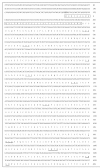Cloning and expression profiling of the VLDLR gene associated with egg performance in duck (Anas platyrhynchos)
- PMID: 21819592
- PMCID: PMC3162882
- DOI: 10.1186/1297-9686-43-29
Cloning and expression profiling of the VLDLR gene associated with egg performance in duck (Anas platyrhynchos)
Abstract
Background: The very low density lipoprotein receptor gene (VLDLR), a member of the low density lipoprotein receptor (LDLR) gene family, plays a crucial role in the synthesis of yolk protein precursors in oviparous species. Differential splicing of this gene has been reported in human, rabbit and rat. In chicken, studies showed that the VLDLR protein on the oocyte surface mediates the uptake of yolk protein precursors into growing oocytes. However, information on the VLDLR gene in duck is still scarce.
Methods: Full-length duck VLDLR cDNA was obtained by comparative cloning and rapid amplification of cDNA ends (RACE). Tissue expression patterns were analysed by semi-quantitative reverse-transcription polymerase chain reaction (RT-PCR). Association between the different genotypes and egg performance traits was investigated with the general linear model (GLM) procedure of the SAS® software package.
Results: In duck, two VLDLR transcripts were identified, one transcript (variant-a) containing an O-linked sugar domain and the other (variant-b) not containing this sugar domain. These transcripts share ~70 to 90% identity with their counterparts in other species. A phylogenetic tree based on amino acid sequences showed that duck VLDLR proteins were closely related with those of chicken and zebra finch. The two duck VLDLR transcripts are differentially expressed i.e. VLDLR-a is mainly expressed in muscle tissue and VLDLR-b in reproductive organs. We have localized the duck VLDLR gene on chromosome Z. An association analysis using two completely linked SNP sites (T/C at position 2025 bp of the ORF and G/A in intron 13) and records from two generations demonstrated that the duck VLDLR gene was significantly associated with egg production (P < 0.01), age of first egg (P < 0.01) and body weight of first egg (P < 0.05).
Conclusions: Duck and chicken VLDLR genes probably perform similar function in the development of growing oocytes and deposition of yolk lipoprotein. Therefore, VLDLR could be a candidate gene for duck egg performance and be used as a genetic marker to improve egg performance in ducks.
Figures





Similar articles
-
Molecular cloning, expression and association study with reproductive traits of the duck LRP8 gene.Br Poult Sci. 2013;54(5):567-74. doi: 10.1080/00071668.2013.819488. Br Poult Sci. 2013. PMID: 24286503
-
Molecular cloning, expression profile, polymorphism and the genetic effects of the dopamine D1 receptor gene on duck reproductive traits.Mol Biol Rep. 2012 Sep;39(9):9239-46. doi: 10.1007/s11033-012-1797-3. Epub 2012 Jun 28. Mol Biol Rep. 2012. PMID: 22740132
-
Cloning, expression, and polymorphism at the 5'-flanking region of the GnRH gene and their association with laying traits in Muscovy duck (Cairina moschata).Br Poult Sci. 2015;56(5):531-42. doi: 10.1080/00071668.2015.1077502. Br Poult Sci. 2015. PMID: 26218061
-
Genetic effects of polymorphisms of candidate genes associated with ovary development and egg production traits in ducks.Anim Reprod Sci. 2019 Dec;211:106219. doi: 10.1016/j.anireprosci.2019.106219. Epub 2019 Oct 28. Anim Reprod Sci. 2019. PMID: 31785640 Review.
-
The study of candidate genes in the improvement of egg production in ducks - a review.Poult Sci. 2022 Jul;101(7):101850. doi: 10.1016/j.psj.2022.101850. Epub 2022 Mar 11. Poult Sci. 2022. PMID: 35544958 Free PMC article. Review.
Cited by
-
Genome-Wide Association Study of Egg-Laying Traits and Egg Quality in LingKun Chickens.Front Vet Sci. 2022 Jun 20;9:877739. doi: 10.3389/fvets.2022.877739. eCollection 2022. Front Vet Sci. 2022. PMID: 35795788 Free PMC article.
-
The association of very low-density lipoprotein receptor (VLDLR) haplotypes with egg production indicates VLDLR is a candidate gene for modulating egg production.Genet Mol Biol. 2016 Jul-Sep;39(3):380-91. doi: 10.1590/1678-4685-GMB-2015-0206. Epub 2016 Jul 14. Genet Mol Biol. 2016. PMID: 27560838 Free PMC article.
-
Identification and Characterization of the Very-Low-Density Lipoprotein Receptor Gene from Branchiostoma belcheri: Insights into the Origin and Evolution of the Low-Density Lipoprotein Receptor Gene Family.Animals (Basel). 2023 Jul 4;13(13):2193. doi: 10.3390/ani13132193. Animals (Basel). 2023. PMID: 37443991 Free PMC article.
-
Cooperation of luteinizing hormone signaling pathways in preovulatory avian follicles regulates circadian clock expression in granulosa cell.Mol Cell Biochem. 2014 Sep;394(1-2):31-41. doi: 10.1007/s11010-014-2078-3. Epub 2014 May 14. Mol Cell Biochem. 2014. PMID: 24825178
-
Endothelin Receptor B2 (EDNRB2) Gene Is Associated with Spot Plumage Pattern in Domestic Ducks (Anas platyrhynchos).PLoS One. 2015 May 8;10(5):e0125883. doi: 10.1371/journal.pone.0125883. eCollection 2015. PLoS One. 2015. PMID: 25955279 Free PMC article.
References
-
- Sakai J, Hoshino A, Takahashi S, Miura Y, Ishii H, Suzuki H, Kawarabayasi Y, Yamamoto T. Structure, chromosome location, and expression of the human very low density lipoprotein receptor gene. J Biol Chem. 1994;269:2173–2182. - PubMed
Publication types
MeSH terms
Substances
LinkOut - more resources
Full Text Sources

